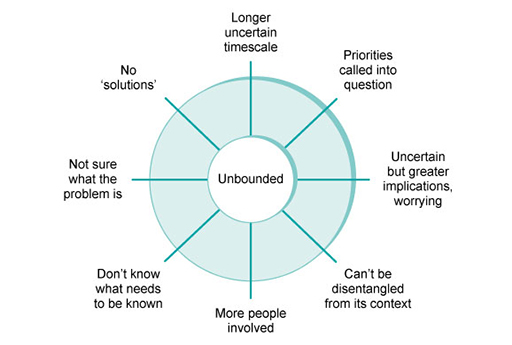5 Problem solving and critical thinking
Day-to-day you are constantly solving problems. These might range from the mundane – ‘do I really want another cup of coffee?’ – to the significant and consequential – ‘is this the right person for me to hire?’.
Yet how often do you reflect on your approach to solving problems?

The word ‘problem’ often describes things you don’t want to do or difficulties that you could easily overcome.
The problem with problems is that they can be difficult to separate from other things. It may be difficult to see where a problem stops and everything else starts, or to disentangle a problem from its context. You then have to consider that seemingly trivial problems may be symptoms of more serious problems.
Understanding the nature of the problem is always a good place to start when problem-solving. Keith Grint argued that ‘Tame Problems are akin to puzzles’ (Grint, 2008, p. 12) as you might be familiar with puzzles and know what to do and you may have a clear sense of what’s important and can anticipate how your changes will affect other things without being too surprised too often. There is, in other words, ‘only a limited degree of uncertainty’ (Grint, 2008, p. 12).
Unlike tame problems, however, wicked problems are less readily resolved (Rittel, 1972). Mason and Mitroff (1981) describe wicked problems as uncertain, complicated, interconnected and ambiguous issues within which there are competing claims and societal constraints. Working with wicked problems places a premium on communicating effectively with those who can help you understand the latest developments. Having the flexibility to accommodate unexpected developments is also needed when dealing with wicked problems.

Wicked problems are both deeply intertwined with their context and unbounded. Consequently, if you act decisively, you may trigger unanticipated consequences and create fresh problems. Today’s world is increasingly interconnected and as a result it can be harder to separate a wicked problem, such as eliminating poverty or achieving world peace, from myriad other interrelated problems.
In order to come up with suitable and effective creative solutions you must focus just as much on understanding the problem and its context as you do the potential solution.
Effective problem solving may involve separating wicked problems, where you must be open minded and agile, from tamer problems that might be easier to solve.
Leaders and managers may catch people’s attention with new solutions to old problems. Yet old problems can persist: wicked problems cannot be tamed; and many apparently tame problems may be less-tame than they first appear.
Activity 6 Tame or wicked?
Think of all the problems that you deal with on a daily basis: are they tame or wicked? Based on whether you believe them to be tame or wicked problems, how might you approach them differently?
Discussion
As you have seen, tame and wicked problems require different approaches. Understanding the nature of the challenge you are dealing with can help you be more effective in how you approach problem solving.
